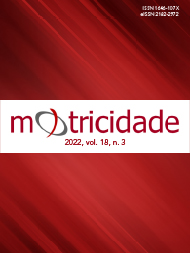Validity and reliability of maximum oxygen uptake on an Air Bike arm- and leg-ergometer
DOI:
https://doi.org/10.6063/motricidade.26611Keywords:
VO2max, leg-ergometer, arm- and leg-ergometerAbstract
Air Bike ergometers have recently appeared and become popular among fitness. These ergometers combine the use of upper or lower limbs while remaining seated. Its characteristic is that of a system of external load imposed through air resistance which increases with the cadence imposed on the equipment. The present study aimed to evaluate the reliability of the ramp test and standard leg-cycle ergometer to assess maximum oxygen uptake (VO2max). For this purpose, 18 physically active young men, aged between 19 and 29 years (mean ± standard deviation= 21.78± 2.44), performed three maximal incremental ramp tests in random order: one test on a cycle ergometer and two tests on an Air Bike arm- and leg- ergometer (test and re-test) with cardiorespiratory measurements throughout the tests. VO2max and maximum heart rate (HRmax) were significantly higher in the Air Bike compared with the cycle ergometer (53.06± 8.72 vs 47.38± 9.15 mL/min/kg), 181.93± 10.20 vs 176.07± 5.28 bpm, p< 0.001; 95%CI 3.41–7.95; ES= 0.30 and p= 0.01; 95%CI 1.44–10.29; ES= 0.34, respectively for VO2max and HRmax). There were no differences between the two ergometers in the maximum respiratory exchange ratio (RER) and test duration (1.21± 0.13 vs 1.21± 0.13, 598.06± 37.28 vs 612.22± 86.40 s, p= 0.9; IC95% –0.05 – –0.05; ES= 0 and p= 0.4; 95%CI –46.12–17.79; ES= –0.11, respectively for RER and test duration). Both VO2max and HRmax showed to be reliable when assessed with the Air Bike ergometer. The maximal test carried out on the Air Bike is a reliable ergometer to assess VO2max and probably enables a higher VO2max as compared with a standard leg-cycle ergometer.
Downloads
Published
Issue
Section
License
The authors of submitted manuscripts must transfer the full copyright to Journal Motricidade / Sílabas Didáticas Editions. Granting copyright permission allows the publication and dissemination of the article in printed or electronic formats, and copyrights start at the moment the manuscript is accepted for publication. It also allows Journal Motricidade to use and commercialise the article in terms of licensing, lending or selling its content to indexation/abstracts databases and other entities.
According to the terms of the Creative Commons licence, authors may reproduce a reasonable number of copies for personal or professional purposes, but without any economic gain. SHERPA/RoMEO allows authors to post a final digital copy (post-printing version) of the article on their websites or on their institutions' scientific repository.


